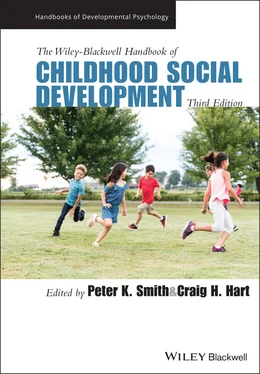Problems in the peer system
Extensive research was undertaken to elucidate the developmental consequences of adverse peer relations during childhood. The impetus, in large part, stemmed from early longitudinal findings (Ladd, 2005) indicating that poor peer relations in childhood were one of the best predictors of adult social and mental health difficulties. Three peer “adversities” received the most empirical scrutiny: peer group rejection, peer exclusion, and peer victimization.
Research on peer rejection focused on children who were disliked by the majority of members of their peer group. Longitudinal findings revealed that rejection by one’s peers, especially when chronic, increased children’s risk for adverse interpersonal and developmental outcomes (Ladd, 2005). Peer exclusion was investigated by identifying and following children who were marginalized by peers (e.g., actively ignored, isolated from interactions and activities). Like rejection, peer exclusion during childhood was linked with unfavorable social and developmental consequences (Buhs et al., 2006). Evidence gathered on peer victimization (e.g., peer maltreatment) revealed that it often had detrimental and, in some instances, life‐threatening consequences. Evidence related to this peer adversity is reviewed in a subsequent section.
Risky child characteristics
Also investigated were child attributes that were conceptualized as risk factors, that is, characteristics that were hypothesized to increase the likelihood of adverse developmental outcomes. Prominent among those investigated were particular behavioral propensities (e.g., aggressive, withdrawn behavior), habitual reaction patterns (e.g., difficult temperament), and enduring maladies (e.g., childhood depression).
Early investigators established that aggressive behavior was quite stable, especially in boys (Olweus, 1979), and follow‐back longitudinal studies showed that delinquent adolescents often were aggressive during childhood (Mulligan et al., 1963). Subsequent longitudinal studies further clarified potential outcomes by showing that early aggressiveness not only predicted later misconduct but also diverse social dysfunctions. To illustrate, researchers followed assaultive fourth‐graders and a sample of matched controls over many years and found that the aggressive children were more likely to develop a range of dysfunctions in adolescence and adulthood, including criminal arrests, teenage motherhood, and psychiatric care (Cairns & Cairns, 1994). Researchers also drew distinctions between direct and indirect aggression (Lagerspetz et al., 1988) and found that both direct and indirect forms of aggression were predictive of maladjustment (Crick, 1996).
Initial research on withdrawn behavior failed to make clear whether it was a stable child characteristic and one that predicted adjustment difficulties (Morris et al., 1954). Later theory and evidence led to the identification of solitary subtypes that were differentiated by children’s propensities to engage in solitary‐anxious, unsociable, or socially avoidant behaviors (Coplan et al., 2013). Longitudinal findings revealed that some forms of withdrawn behavior became increasingly stable as children matured and were predictive of adjustment problems (Ladd, 2006). Conclusions remain tentative, but extant evidence implied that solitary‐anxious behavior, in particular, anteceded the development of interpersonal and internalizing problems (Gazelle & Ladd, 2003).
Certain configurations of child temperament were investigated as risk factors, particularly those characterized as low in extroversion‐surgency (e.g., shy, inhibited) and low in effortful control or high in negative affectivity (e.g., under controlled, “difficult”). Findings suggested that, whereas inhibited children were likely to develop internalizing problems, those deficient in regulation abilities, such as effortful control, tended to develop externalizing problems (Rothbart et al., 2011). Children disposed toward negative affectivity had a higher probability of developing aggressive behavior or conduct problems (Mathiesen & Prior, 2006). Overall, evidence suggested that temperaments skewed toward characteristics such as emotionality, impulsiveness, and irritability increased children’s risk for adjustment difficulties (Rothbart, 2007; Rothbart et al., 2011).
Depression was at the forefront of the childhood maladies investigated because it posed a serious threat to mortality. Moreover, theory and evidence implied that depression’s effects on children (e.g., impaired cognitive, emotional, interpersonal functioning; Nolen‐Hoeksema et al., 1992) were likely to alter the course of their social development. Evidence gathered in longitudinal studies attested to the stability of depressive symptoms during childhood (Nolen‐Hoeksema et al., 1992) and revealed that children who suffered moderate to severe episodes of depression during childhood were more at risk for suicide and prone to manifest social, emotional, and personality dysfunctions as adults (Akingbuwa et al., 2020; Kasen et al., 2001).
Major Transformations in Social Development Research
Foremost among the factors that precipitated transformations in social development research over the past 50 years were innovations in developmental theory, the emergence of pressing sociocultural issues and public health crises, and advances in scientific research methods and analytic strategies. Consideration is given to how these forces transformed researchers’ objectives and altered the purview of social development research.
Transformations in theories and models of development
Perhaps the foremost overarching theoretical innovation was the progressive transformation that occurred in scientists’ conceptions of the causes of development (i.e., bio‐psycho‐social determinants) and the dynamics of development (i.e., processes that shape growth and outcomes). Previously in the discipline’s history, research on development cycled through epochs during which either naturist or nurturist perspectives dominated scientific inquiry. As a result, when “development” was inferred from findings, it was typically attributed to maturational or environmental determinants, but not both. This state of affairs, in turn, fueled the nature versus nurture controversy.
Across the past several decades, the roles of nature and nurture as determinants of development were reconceptualized in ways that gave rise to novel, integrated perspectives. Behavioral geneticists, for example, postulated that environments influenced genetic expression (e.g., milieus amplify vs. canalize gene influence; Plomin, 1995) and, conversely, that genes shaped the developing organism's environment (Scarr & McCartney, 1983). In the latter paradigm, three modes of influence, or gene by environment interactions, were proposed (i.e., passive, evocative, active), each of which depicted distinct avenues through which children’s genotypes affected the form, quality, or responses of their rearing environments. These models broadened preexisting premises about the causes of development by postulating that biological and environmental determinants not only influenced each other but also worked conjointly to foster development.
Interactionist perspectives emerged alongside behavioral genetic frameworks and evolved into what were eventually termed person‐by‐environment models or, in the context of developmental research, child‐by‐environment models (Magnusson & Stattin, 1998). A central premise of child‐by‐environment models was that the determinants of development originate not only within the child but also in the child’s social environment. Guided by this premise, researchers often focused on stable, organismic characteristics of the child (e.g., temperament, behavioral dispositions) and pertinent features of the child’s social environment (e.g., quality of caregiver or peer relationships) and examined both factors as antecedents of children’s development. Over time, multiple categories of child‐by‐environment frameworks (e.g., additive, moderator, and mediator models; Ladd, 2003) were proposed and utilized to investigate how particular child and environmental characteristics operated together (e.g., combined) to influence development. Thus, similar to the innovations in behavioral genetic theory, child‐by‐environment frameworks encouraged scientists to conceptualize development as a product of organismic and environmental forces, and investigate these determinants as conjoint rather than singular influences.
Читать дальше












